#micropre
Explore tagged Tumblr posts
Text
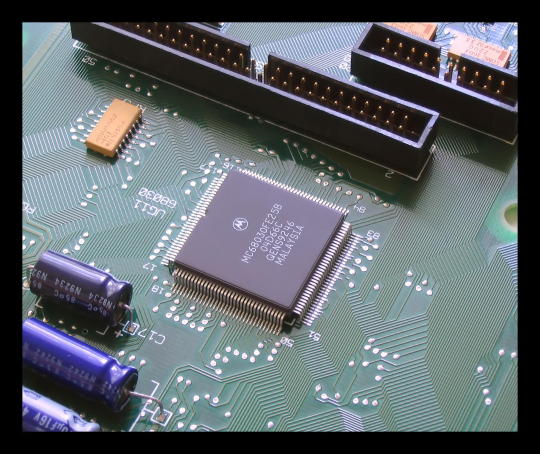
1 note
·
View note
Text


Finally got an optic on all of my uppers. I am still short one bolt for total completion.
This is my general 5-minute first impression of all of the optics-
Vortex strike eagle 1-6x24 : honestly, this is great. It should be noted. This version is technically discontinued It has been replaced by the vortex venom 1-6x24. Having played with this for about 20 minutes, I'm happy with it. Especially because I paid $230 for it and one of the american-made leapers mounts. However, I would totally have paid full Price having held it. It isn't a primary arms Acss Nova, And if you can get your hands on anova for a similar price, I would definitely get the Nova over The strike eagle or the venom. Max brightness is definitely bright enough for daytime use, But it's not Red dot Bright.
Primary arms acss 5x slx microprism:
Honestly, really impressed. The Chevron is bright and clear, the etching is extremely sharp, the outer reticle gets blurry during motion, but I noticed that with all my optics, so I think that's my eyes.
It does have a super short eye relief, longer than a ACOG, but still shorter than any LPVO I've used.
Sig Romeo MSR gen II:
The body of the optic takes up quite a bit of room in your field of view. This is made up for by the almost total lack of a notch filter. It is only noticeable when aiming directly at something white. It might only be a 7/10, But it almost breaks into the 8's
6 notes
·
View notes
Text
Camera Showcase
Olympus OM2 Spot Program
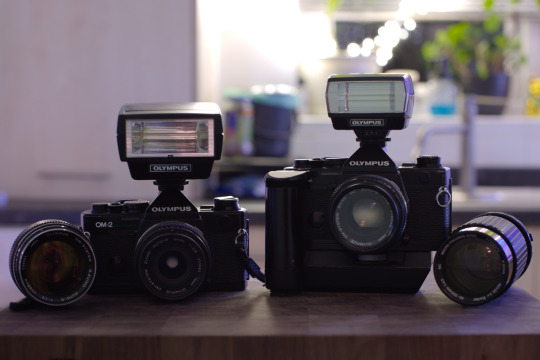
Pictured: Olympus OM2 Spot Programs with all owned OM specific lenses, flash units and motor winder
In the OM series of cameras, double digits such as the OM10 were consumer grade, whereas single digits were professional grade. First manufactured in 1984, the OM2 Spot Program (OM2S in the US) was a thorough overhaul of the OM2 to make it more competitive, meaning it's internals have more in common with the OM4 than it's predecessor.
Personally speaking, this is the most feature-rich, reliable 35mm film camera I have owned, making it my go-to workhorse for 35mm work. It’s compact design was very well-thought out and lightweight compared to other cameras before it.
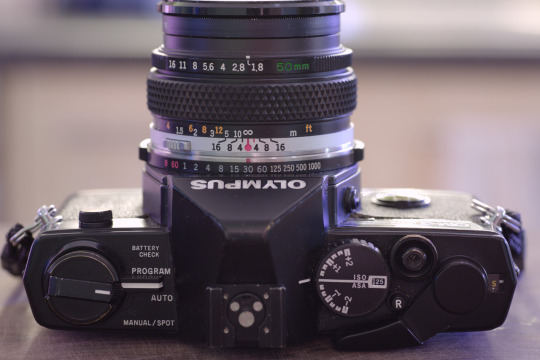
Pictured: Top view of the OM2 Spot Program highlighting camera controls
One of the really well-thought out designs of this camera is how the shutter speed, aperture and depth of field preview controls are all in the same area on or next to the lens, meaning with one hand you can set all the main exposure controls without looking away from the viewfinder. Instead of a shutter speed selector on top, it’s a combined ISO speed/exposure compensation dial.
The OM2 Spot Program has 3 shooting modes: Program, Auto and Manual/Spot. In Program, the lens is set to the highest/tightest aperture and the camera will set both the aperture and shutter speed according to the light levels. In Auto, the camera shoots in an aperture priority mode where the user sets the aperture and the camera deals with the rest. In both Program and Auto modes, the camera meters centre weighted but in the full manual mode the camera switches to spot metering. This is an extremely useful feature when shooting high contrast images and with light sources behind the subject matter.
Another great thing versus it's predecessors is that it has a mechanical 1/60th shutter speed option, meaning if the batteries are depleted mid-shoot there's still a way to take photos depending on light levels.
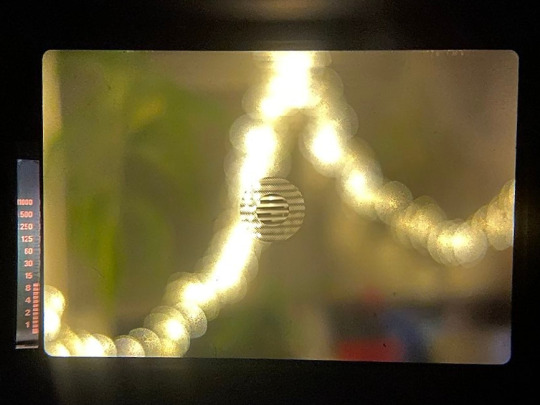
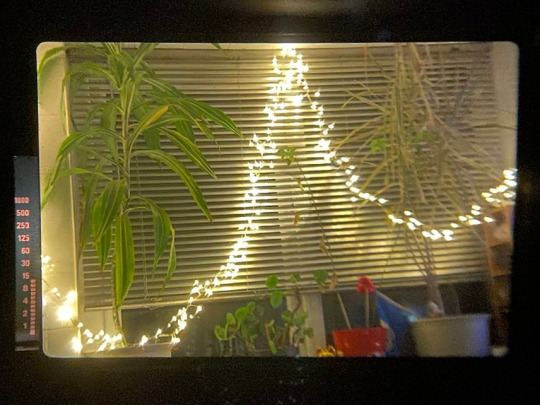
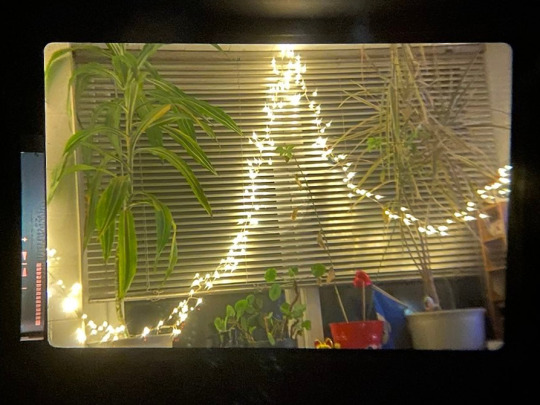
Pictured: 3 shots through the viewfinder showing the current focus screen's split centre and microprism centre, the Program/Auto mode metering and the Spot/Manual's digital match needle meter
The viewfinder's light meter is a LCD style display which can be illuminated for 90 seconds for better viewing in low light scenes. In Manual/Spot mode it switches from a bar depicting the shutter speed to a match needle style display. The viewfinder itself (dependant on chosen focus screen) is very clear and bright making composition a lot easier.
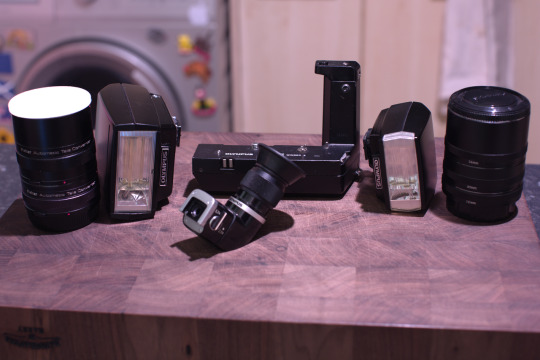
Pictured: A selection of various attachments for the OM series of cameras. teleconverters, extension tubes, right-angle viewfinder, motor winder and flash units
The OM series of cameras have a wide range of accessories to further extend the capabilities of this camera. The motor winder allows for shooting up to 3.5 frames a second in continuous mode. The right angle viewfinder is especially useful when shooting at awkward angles or with telephoto lenses on a tripod, and has a toggle switch to add a 2.5x magnification to it for really dialling in the focus. I have a T20 and T32 flash for my cameras, and although the more lightweight and smaller T20 is more portable and uses half the amount of batteries, I prefer the T32 as it allows for bounce flash photography. Both flash units have 3 modes: TTL camera auto, flash unit auto and full manual. I have only really used the TTL camera auto mode but with the lens set to f4 I haven't had any photos with blown out highlights or muddy shadows.
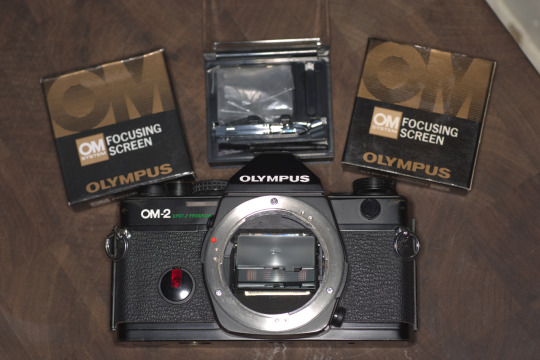
Pictured: three different focus screens and an OM2 Spot Program with no lens and the current focus screen unclipped from the camera
A great thing about the OM2 Spot Program and other single digit OM cameras is the ability to fairly easily switch focus screens. Different lenses and scenarios work better with different screens and the ability to change really increases the versatility of the camera. For example, for general use I tend to use a split centre with microprism focus screen to give me 3 ways to focus, but with a telephoto (especially with teleconverters) the split centre goes black due to the low light levels. At that point, I have the option to switch to a microprism only or ground glass screen to make it easier to focus.
All in all, a fantastic camera with a solid design, accurate light meter and a wide selection of lenses and attachments which if in good condition will be a fantastic addition to any vintage camera collection.
#photography#film photography#ishootfilm#analog photography#filmisnotdead#vintage cameras#camera review#35mm film#35mm format#reviews#retro camera#olympus camera#olympus om2sp#olympuscamera#35mm camera#analog camera#old camera#camera#om2sp
3 notes
·
View notes
Text

Canon EOS 300D Digital, Zenit Helios 44M-4, f/8, 58mm, 1/1000s, ISO 100; 24.09.2023
[ENG] This photo shows a fragment of the village where I live. It's a typical tourist village where farmers are the exception, and many people rent rooms to tourists or don't live here at all; they just come for the summer from their homes in Warsaw, Olsztyn, or other cities.
An interesting thing about this photo is what I used to take it. I don't know if you're one of those people who pay attention to technical details that I've been providing recently with each photo here, but if not, take a look. This is this year's photo taken with a camera that might be older than you and a lens that certainly is. I enjoy these kinds of experiments, reminiscing about how it used to be when you couldn't set everything to auto. Manual focus settings? Sure thing. Sometimes it's especially challenging because ever since cameras have had autofocus systems, they come with brighter focusing screens, but without the split prism or microprism collar that made working with manual lenses easier. It also happens that the autofocus system in a new camera can be misleading. I had this issue with the Helios lens attached to my R6. Canon's autofocus assist showed that the focus was spot on, but it was actually beyond the subject. Anyone who has dealt with these things should give it a try. Having this perspective helps not to get caught up in today's shortcomings. From the perspective of someone who has been taking photos for a few decades, arguments about the superiority of one camera over another seem funny to me. Yes, I see the differences, but I once had a camera with only one functional autofocus point. So, the difference between 2500 points and 500 points seems insignificant to me in both cases. In both cases, it's more than enough and shouldn't limit anyone.
And besides... it's a beautiful village, isn't it? Because that's what this hobby is mostly about. So, I apologize for my equipment digressions. I'll wrap it up for today. Greetings.
[PL] To zdjęcie przedstawia fragment wsi w której mieszkam. Jest to typowo turystyczna wieś gdzie rolnicy to wyjątek a mnóstwo ludzi wynajmuje pokoje turystom lub w ogóle tu nie mieszkają tylko przyjeżdżają na lato ze swoich domów w Warszawie, Olsztynie czy innym Bytomiu.
Ciekawostką jest to, czym zrobiłem to zdjęcie. Nie wiem czy jesteś jedną z tych osób które zwraca uwagę na dane techniczne które od niedawna podaję pod każdą fotką tutaj ale jeśli nie to popatrz. Oto mamy tegoroczne zdjęcie robione aparatem, który być może jest starszy od Ciebie i obiektywem który z pewnością jest. Lubię takie zabawy. Przypomnieć sobie jak to było kiedy nic nie dało się ustawić na auto. Manualne ustawianie ostrości? Proszę bardzo. Czasami jest to wyjątkowo trudne bo odkąd aparaty mają układ AF to wyposażane są w jaśniejsze matówki ale za to bez rastra czy klina które ułatwiały pracę z manualnymi szkłami. Bywa, też tak, że układ wspomagający ostrość w nowym aparacie przekłamuje. Tak miałem z tym właśnie Heliosem podpiętym od R6. Wspomagacz Canona pokazywał, że ostrość jest w punkt a była już za obiektem. Kto z takimi rzeczami się nigdy nie zmagał ten powinien spróbować. Posiadanie tej perspektywy pomaga w nieprzejmowaniu się dzisiejszymi niedostatkami. Z perspektywy kogoś kto fotografuje już pare dekad śmieszne są dla mnie spory o wyższości jednego aparatu nad drugim. Tak. Dostrzegam różnice ale kiedyś miałem aparat z jednym funkcjonalnym punktem AF. Więc taka różnica między 2500 punktów a 500 punktów wydaje mi się nieistotna. W obu wypadkach jest to dostatecznie dużo i nie powinno nikogo ograniczać.
A poza tym... Ładna wieś, nie? Bo to bardziej o to w tym sporcie chodzi. Także przepraszam za wynurzenia sprzętowe. Kończę na dziś. Pozdrawiam.
2 notes
·
View notes
Text
Micropricing
I got pinged for implying phone services were overcharging for "caller ID and Visual Voicemail" on truth social. So I'm going into one of the ways businesses take advantage of users: Micropricing.
First, Caller ID is already built into the system. It has been for at least three decades. Back then it might've cost more to send you a name attached to the number it wouldn't show you either. But that's why we had phone books and answer machines.
Now, spam-robots can call you daily for much less than it costs you to keep your phone connected to the service you're paying for. And because of the Micropricing strategy, the phone companies "can't afford to use their decades old technology in new and innovative ways that protect customers."
Visual Voicemail, on the other hand, is an app that lets you look at who left a message and other details of the sound file attached to it, without having to call you voicemail and do it by touch tone like we're in mad men. And yes, it provides a transcription of the message left. Which is simply an accessibility feature for hard of hearing that they're allowed charge extra for, because they can.
And you wonder why we would rather you just send a text message.
Anyway, Micropricing is a strategy to charge more for services that don't actually cost the company more to provide. And sometimes, for things the user will never use. And sometimes, phone insurance which ultimately costs the user more to use than a phone repair service. (And they don't even help track down lost or stolen devices, EVEN THOUGH THEY CAN. AND YOU PAY A SERVICE FOR PROTECTION.)
A lot of these services are collapsing because the Internet allows more rich data to be sent more efficiently. But here's the thing: old services are tacked onto your bill automatically. we can't*not use them* but phone companies won't update either. So we pay to get the updated old tech that isn't as good as should be standard ten years ago.
A lot of the digital features today aren't like owning a car phone in the 70s. Cell Phones have been the defacto standard for 20 years now. The only thing different is data usage. Which may or may not be restricted thanks to cell tower bandwidth. But in a college town where the bandwidth is always maxed out and everybody needs to use wifi, you're just having people pay to not use the features that worked better ten years ago.
Infrastructure should include phone and internet service. Then *private* companies can just be the fastlane they claim to want to build. But instead they're focused on charging extra for standard features.
Look. Trains caused the word to have to keep pace with a 24 hour clock schedule.
The Internet means the world needs to get off its addiction of 5-year and 10-year plans hoping for people to die before anything can be done to change anything.
Even six months is too long for deliberation. Yeah, it used to be worse, but that's the whole f*ing reason we built technology in the first place, so it wouldn't have to be.
2 notes
·
View notes
Text
I love Zenni but I need to point out that they can only make common prescriptions accurately. If you have special eyes (atypical binocular vision dysfunction for instance) the cheaper places like Zenni aren't going to be able to do the really tiny adjustments. I have microprisms and Zenni can't make them correctly.
If you're bog standard near- or far-sighted go for it, they're great for that. But the unicorns should get insurance. (EyeMed works for me)
where are those startups that are disrupting the glasses industry
236K notes
·
View notes
Text
Reflective Materials for Clothing Market, Global Outlook and Forecast 2025-2032
Reflective materials for wearing apparel refer to fabrics, tapes, or films that are designed to reflect light, enhancing visibility in low-light conditions. These materials are commonly used in safety clothing, uniforms, and other forms of protective gear. The core technology of reflective materials involves either tiny glass beads or microprisms embedded in the fabric or film, allowing light to reflect back to its source from a wider angle than traditional reflective materials. This technology ensures that the wearer is visible from greater distances and angles, making these materials vital for industries where safety is paramount.
The primary types of reflective materials include glass bead and microprismatic materials. Glass bead technology uses small glass beads that reflect light by bending and scattering it in various directions. Microprismatic materials, on the other hand, use microscopic prisms that reflect light more effectively by returning it at a wider angle, providing superior reflectivity. Reflective materials are utilized in various applications, ranging from construction and industrial workwear to sportswear, activewear, and transportation safety.
Download FREE Sample of this Report @ https://www.24chemicalresearch.com/download-sample/286718/global-reflective-materials-for-clothing-forecast-market-2025-2032-859
Market Size
The global market for reflective materials in clothing was valued at USD 937.10 million in 2023, with projections indicating it will reach USD 1.94 billion by 2032, growing at a CAGR of 11.00% during the forecast period. This market growth is fueled by increased awareness regarding workplace safety, as well as the growing demand for enhanced visibility in various sectors such as construction, transportation, and mining. In addition, innovations in reflective material technologies, such as the development of microprismatic materials, are driving the demand for these products.
Reflective materials are primarily used in the manufacture of high-visibility clothing and safety apparel, which ensures that individuals are seen in low-light environments, thus reducing the risk of accidents. The demand for such products has surged globally, with regions such as North America and Europe witnessing steady growth. The increasing focus on worker safety and rising regulatory standards for high-visibility clothing are also contributing factors to the expansion of this market.
Market Dynamics (Drivers, Restraints, Opportunities, and Challenges)
Drivers:
Several factors contribute to the growth of the reflective materials market for clothing. One of the primary drivers is the growing emphasis on safety regulations across industries like construction, mining, and utilities. Governments are increasingly mandating the use of high-visibility clothing in hazardous working environments, spurring demand for reflective materials. Additionally, the expanding automotive and transportation sectors, particularly in terms of vehicle visibility and roadside worker safety, continue to drive the need for reflective materials in uniforms and garments.
Technological advancements in reflective material manufacturing also play a crucial role. Innovations in microprismatic and glass bead technologies allow manufacturers to produce materials that provide greater reflectivity with less material, reducing costs while enhancing product efficiency.
Restraints:
Despite the market's promising growth, there are several challenges that may impact its expansion. One of the main restraints is the high cost of manufacturing high-quality reflective materials, particularly microprismatic materials, which could limit their adoption in cost-sensitive markets. The requirement for continuous innovation to meet regulatory standards also puts pressure on manufacturers, increasing operational costs.
Additionally, the environmental impact of synthetic reflective materials and the challenge of recycling them at the end of their life cycle are growing concerns. The need to balance cost-effectiveness with sustainability is an ongoing challenge in the market.
Opportunities:
The rise in active and recreational sports also presents an opportunity for the reflective materials market. As more people engage in outdoor activities such as cycling, running, and hiking, there is a growing demand for safety gear that incorporates reflective elements. The global trend of sportswear becoming a part of everyday fashion also opens new opportunities for incorporating reflective materials into mainstream apparel.
Moreover, emerging markets in regions such as Asia-Pacific and Latin America represent a significant growth opportunity. As industrialization and urbanization continue to rise in these regions, there is an increasing need for reflective apparel in various sectors such as construction, oil and gas, and transportation.
Challenges:
One of the key challenges in the reflective materials market is the intense competition among manufacturers. With numerous players in the market, companies are pressured to differentiate themselves through innovation and pricing strategies. Additionally, the rapid pace of technological change means that companies must continuously adapt to maintain a competitive edge.
The fluctuating prices of raw materials, particularly the costs of glass beads and other essential components used in reflective fabrics, can also create uncertainty in pricing and supply chain operations.
Regional Analysis
North America:
In 2023, the North American market for reflective materials in clothing was valued at USD 244.18 million. The region is expected to grow at a CAGR of 9.43% from 2025 to 2032. The United States, in particular, plays a key role in driving demand for reflective materials, due to stringent safety regulations in construction, transportation, and industrial sectors. The popularity of activewear and outdoor activities also contributes to the demand for reflective materials in clothing.
Europe:
Europe is another significant market for reflective materials, driven by strict safety regulations and a high focus on worker protection. Countries like Germany, the UK, and France are key players in this market. The region is expected to see moderate growth as it increasingly adopts high-visibility standards across various industries, including construction, transportation, and emergency services.
Asia-Pacific:
The Asia-Pacific region is expected to experience the highest growth rate during the forecast period. As industrialization and urbanization accelerate in countries like China, India, and Southeast Asia, there is an increasing demand for safety clothing, which drives the market for reflective materials. Additionally, the rise in outdoor recreational activities in this region further boosts demand.
South America:
Countries like Brazil and Argentina are gradually adopting safety regulations, which is contributing to a steady rise in demand for reflective clothing. Although this market remains relatively small, it holds growth potential in the coming years as safety standards continue to evolve.
Middle East and Africa:
The Middle East and Africa (MEA) market is driven by industries such as oil and gas, construction, and mining, where worker safety is a priority. However, the market in this region is still in its nascent stages, with growth expected as infrastructure development increases.
Competitor Analysis
Key players in the reflective materials market for clothing include 3M, Avery Dennison, Daoming Optics and Chemical, Coats, ORAFOL, and Hangzhou Chinastars, among others. These companies are at the forefront of innovations in reflective materials, particularly in developing microprismatic and glass bead technologies. Many of these players also have a global presence and serve a diverse range of industries, including construction, mining, and transportation.
The market is highly competitive, with companies continuously striving for innovation and efficiency. Price sensitivity in emerging markets, as well as the demand for high-quality, durable materials, creates a competitive landscape where companies must differentiate themselves based on product performance and value.
Global Reflective Materials for Clothing: Market Segmentation Analysis
This report provides a deep insight into the global Reflective Materials for Clothing market covering all its essential aspects. This ranges from a macro overview of the market to micro details of the market size, competitive landscape, development trend, niche market, key market drivers and challenges, SWOT analysis, value chain analysis, etc.
The analysis helps the reader to shape the competition within the industries and strategies for the competitive environment to enhance the potential profit. Furthermore, it provides a simple framework for evaluating and assessing the position of the business organization. The report structure also focuses on the competitive landscape of the Global Reflective Materials for Clothing Market, this report introduces in detail the market share, market performance, product situation, operation situation, etc., of the main players, which helps the readers in the industry to identify the main competitors and deeply understand the competition pattern of the market.
In a word, this report is a must-read for industry players, investors, researchers, consultants, business strategists, and all those who have any kind of stake or are planning to foray into the Reflective Materials for Clothing market in any manner.
Market Segmentation (by Application)
Construction
Utilities
Industrial
Transportation
Firefighter
Active and Recreational
Mining, Oil and Gas
Market Segmentation (by Type)
Glass Beads
Microprismatic
Key Company
3M
Avery Dennison
Daoming Optics and Chemical
Coats
ORAFOL
HJ Lite
IRC Spa
Loxy
Hangzhou Chinastars
Changzhou Hua R Sheng
Giolite-Lumian
Zhejiang YGM
Yeshili New Materials
XW Reflective
Geographic Segmentation
North America (USA, Canada, Mexico)
Europe (Germany, UK, France, Russia, Italy, Rest of Europe)
Asia-Pacific (China, Japan, South Korea, India, Southeast Asia, Rest of Asia-Pacific)
South America (Brazil, Argentina, Columbia, Rest of South America)
The Middle East and Africa (Saudi Arabia, UAE, Egypt, Nigeria, South Africa, Rest of MEA)
FAQ
What is the current market size of the Reflective Materials for Clothing market?
➣ The market size was USD 937.10 million in 2023 and is expected to reach USD 1.94 billion by 2032.
Which are the key companies operating in the Reflective Materials for Clothing market?
➣ Key companies include 3M, Avery Dennison, Daoming Optics and Chemical, Coats, ORAFOL, and Hangzhou Chinastars.
What are the key growth drivers in the Reflective Materials for Clothing market?
➣ Key drivers include stringent safety regulations, technological advancements, increased demand for safety clothing in high-risk industries, and the rising popularity of outdoor recreational activities.
Which regions dominate the Reflective Materials for Clothing market?
➣ North America, Europe, and Asia-Pacific are dominant regions in the global reflective materials market, with North America leading in demand for worker safety products.
What are the emerging trends in the Reflective Materials for Clothing market?
➣ Emerging trends include the growth of the activewear market, increased focus on sustainable production methods, and innovations in microprismatic materials for enhanced reflectivity.
Key Benefits of This Market Research:
Industry drivers, restraints, and opportunities covered in the study
Neutral perspective on the market performance
Recent industry trends and developments
Competitive landscape & strategies of key players
Potential & niche segments and regions exhibiting promising growth covered
Historical, current, and projected market size, in terms of value
In-depth analysis of the Reflective Materials for Clothing Market
Overview of the regional outlook of the Reflective Materials for Clothing Market:
Key Reasons to Buy this Report:
Access to date statistics compiled by our researchers. These provide you with historical and forecast data, which is analyzed to tell you why your market is set to change
This enables you to anticipate market changes to remain ahead of your competitors
You will be able to copy data from the Excel spreadsheet straight into your marketing plans, business presentations, or other strategic documents
The concise analysis, clear graph, and table format will enable you to pinpoint the information you require quickly
Provision of market value (USD Billion) data for each segment and sub-segment
Indicates the region and segment that is expected to witness the fastest growth as well as to dominate the market
Analysis by geography highlighting the consumption of the product/service in the region as well as indicating the factors that are affecting the market within each region
Competitive landscape which incorporates the market ranking of the major players, along with new service/product launches, partnerships, business expansions, and acquisitions in the past five years of companies profiled
Extensive company profiles comprising of company overview, company insights, product benchmarking, and SWOT analysis for the major market players
The current as well as the future market outlook of the industry concerning recent developments which involve growth opportunities and drivers as well as challenges and restraints of both emerging as well as developed regions
Includes in-depth analysis of the market from various perspectives through Porter’s five forces analysis
Provides insight into the market through Value Chain
Market dynamics scenario, along with growth opportunities of the market in the years to come
6-month post-sales analyst support
Download FREE Sample of this Report @ https://www.24chemicalresearch.com/download-sample/286718/global-reflective-materials-for-clothing-forecast-market-2025-2032-859
0 notes
Text
From Theory to Practice: Real-world Applications of Microprisms in Optical Interferometry
Introduction
Microprisms have revolutionized the field of optical interferometry, allowing for precise measurements and imaging in a wide range of applications. These tiny devices, typically made from https://toweroptical.com/contact-us/ high-quality glass or other transparent materials, are designed to redirect light beams with incredible accuracy. In this article, we will explore the real-world applications of microprisms in optical interferometry, highlighting their importance and impact in various industries.
The Evolution of Microprisms The Early Days: Development and Advancements Modern Innovations: Miniaturization and Enhanced Performance Microprism Technology Explained What are Microprisms? Types of Microprisms Right-Angle Microprisms Dove Prisms Penta Prisms Roof Prisms Real-world Applications of Microprisms in Optical Interferometry Aerospace Industry Precision Measurement and Alignment Systems for Aircraft Manufacturing Optical Navigation Systems for Spacecraft Medical Field Ophthalmology: Precise Eye Measurements for Vision Correction Surgery Endoscopy: Improved Visualization for Minimally Invasive Procedures Manufacturing Sector Quality Control and Inspection in Semiconductor Industry Metrology: Accurate Measurement of Automotive Components Scientific Research and Development Laser Interferometry: Measuring Surface Topography with Sub-Nanometer Accuracy Spectroscopy: Enhancing Light Collection and Detection Efficiency Defense and Security Applications Target Acquisition and Tracking Systems for Military Operations Surveillance and Reconnaissance Systems FAQs about Microprism Applications in Optical Interferometry What is the primary advantage of using microprisms in optical interferometry? Microprisms allow for precise redirection of light beams, enabling accurate measurements and imaging. How do microprisms contribute to the aerospace industry? Microprisms are used in precision measurement and alignment systems for aircraft manufacturing, as well as optical navigation systems for spacecraft. What role do microprisms play in medical applications? In ophthalmology, microprisms enable precise eye measurements for vision correction surgery. They also enhance visualization in endoscopy procedures. How are microprisms utilized in the manufacturing sector? Microprisms play a crucial role in quality control and inspection processes in the semiconductor industry. They are also used for accurate metrology in automotive component measurement. What scientific research fields benefit from microprism applications? Laser interferometry relies on microprisms to measure surface topography with sub-nanometer accuracy. Microprisms also enhance light collection and detection efficiency in spectroscopy. How do microprisms contribute to defense and security applications? Microprisms are utilized in target acquisition and tracking systems for military operations, as well as surveillance and reconnaissance systems. Conclusion
Microprisms have proven to be invaluable tools in optica
youtube

1 note
·
View note
Link
Have you seen this Springfield Hellion Bullpup Giveaway from Primary Arms? Check it out and enter to win! https://wn.nr/BwPJkmU Hey, Have you seen this Springfield Hellion Bullpup Giveaway from Primary Arms? Check it out and enter to win! If you refer a friend you receive more chances to win! Here is the link to use to enter to win. https://wn.nr/BwPJkmU
0 notes
Text
Primary Arms Optics lanza el nuevo microprisma GLx 1x
Primary Arms Optics ha anunciado el lanzamiento de la GLx® 1x MicroPrism, una óptica de prisma compacta y versátil construida para un rendimiento óptimo de los espacios cerrados sin verse afectada por el astigmatismo. Diseñado como una evolución del popular SLx® MicroPrism, el GLx 1x MicroPrism ofrece una gama de mejoras que lo converten en la solución ideal para los tiradores que buscan una…
0 notes
Text
Primary Arms GLx 1x MicroPrism Optic with ACSS Cyclops Reticle - Advanced Optics Line
Primary Arms has announced the release of their new premium GLx 1x MicroPrism optic featuring the ACSS Cyclops reticle. Primary Arms states “The Primary Arms GLx MicroPrism™ brings new technology and enhanced optical performance to the close-quarters prism scope. With its wider objective lens and updated internal design, the GLx 1x MicroPrism offers superior glass quality and edge-to-edge…
0 notes
Text
0 notes
Text
The Role of Reflective Tape in Enhancing Worker Safety
In various industries, worker safety is a paramount concern. Whether it’s construction, manufacturing, or any other field that involves potential hazards, ensuring that workers are visible and protected is critical. One of the most effective and straightforward tools to enhance worker safety is reflective safety tape. This post explores the significant role of reflective tape in improving worker visibility and overall safety, highlighting its benefits and applications.
What is Reflective Safety Tape?
Reflective safety tape is a type of adhesive material designed to reflect light back to its source, making it highly visible in low-light conditions. This tape is commonly used on work clothing, equipment, and vehicles to enhance visibility. The material used in reflective safety tape typically includes microprisms or glass beads, which are highly effective in reflecting light.
Importance of Reflective Safety Tape
Enhanced Visibility: The primary purpose of reflective safety tape is to increase visibility. Workers who operate in low-light conditions or at night are at a higher risk of accidents. Reflective tape makes them easily visible to others, including drivers and machinery operators, thereby reducing the risk of accidents.
Compliance with Safety Standards: Many industries have stringent safety regulations that require the use of reflective materials on work clothing and equipment. Using reflective safety tape helps companies comply with these regulations, ensuring a safer working environment and avoiding potential fines and legal issues.
Versatility and Ease of Use: Reflective safety tape can be applied to a variety of surfaces, including helmets, jackets, vehicles, and machinery. Its adhesive nature makes it easy to apply, and it can be cut to size, making it a versatile option for enhancing safety across different scenarios.
Applications of Reflective Safety Tape
Reflective safety tape is used in numerous applications across various industries:
Construction Sites: Workers on construction sites often work near heavy machinery and moving vehicles. Applying reflective safety tape to their clothing, helmets, and equipment ensures they are visible to drivers and equipment operators, reducing the risk of accidents.
Roadside Work: Roadside workers, such as those involved in maintenance and repairs, are at high risk due to passing traffic. Reflective tape on their clothing and tools increases their visibility to motorists, thereby enhancing their safety.
Emergency Services: Police, fire, and medical emergency services often operate in hazardous and low-light environments. Reflective safety tape on their uniforms and equipment helps them stay visible, ensuring their safety as well as that of the public.
Warehouse and Industrial Settings: In warehouses and industrial settings, where forklifts and other machinery are in constant use, reflective tape can be used to mark safe pathways, emergency exits, and hazardous areas, enhancing overall safety.
Quality Reflective Tape Products
For those seeking high-quality reflective safety tape, it is essential to choose reliable suppliers. One such source is https://mytapestore.com.au/. This online store offers a wide range of reflective tapes designed to meet various safety needs. Their products are known for their durability and high reflectivity, ensuring long-lasting performance even in demanding environments.
Conclusion
Reflective safety tape plays a crucial role in enhancing worker safety across multiple industries. Its ability to improve visibility, comply with safety standards, and provide versatile application options makes it an indispensable tool for protecting workers. By investing in quality reflective tape from trusted suppliers like https://mytapestore.com.au/, companies can significantly reduce the risk of accidents and create a safer working environment for their employees.
0 notes
Text
The Science of Reflective Materials: How Do They Work?
Have you ever wondered how those eye-catching reflective materials make objects glow in the dark? From safety gear like reflective vests to road signs and bicycle accessories, these materials play a crucial role in enhancing visibility and safety during low-light conditions. In this blog, we will explore the fascinating science behind reflective materials and unravel the secrets of how they work, including the role of glass bead technology.
The Basics of Reflection
To understand how reflective materials work, let’s begin with the fundamental concept of reflection. Reflection is the phenomenon where light rays bounce off the surface of an object. When light strikes an object, it can either be absorbed by the material, transmitted through it, or reflected back.
The Science Behind Reflective Materials
Retroreflection
The key to the effectiveness of reflective materials lies in a specific type of reflection called retroreflection. Unlike regular reflection, where light bounces off a surface in random directions, retroreflection occurs when light rays are sent back towards the source almost parallel to the incident direction. This means that the light returns directly to the observer’s eye, making the object highly visible even from a distance.
Microscopic Glass Beads and Prisms
One of the most common technologies used in reflective materials is glass bead technology. Reflective materials employ glass beads or microprisms technology. This involves coating the material with countless tiny glass beads or embedding microprisms. When light hits these elements, they internally reflect it within the glass bead or prism, redirecting it back toward the light source, thus producing retroreflection.
Angle of Incidence
Another crucial aspect of reflective materials is the angle of incidence. The angle at which light strikes the reflective surface determines the angle at which it is retroreflected. Engineers and designers carefully consider this angle to ensure optimal visibility from different viewpoints.
The Applications of Reflective Materials
Reflective materials find application in various industries due to their ability to improve visibility and safety. Some common uses include:
Road Safety: Reflective road signs, lane markings, and traffic cones use reflective materials with glass bead technology to enhance visibility for drivers during nighttime or adverse weather conditions.
Personal Safety: Reflective vests, jackets, and accessories worn by pedestrians, cyclists, and construction workers increase their visibility to motorists and others, reducing the risk of accidents.
Outdoor Gear: Reflective elements on outdoor gear like backpacks and shoes help hikers, runners, and cyclists stay visible during their adventures.
Emergency Services: Rely on reflective materials to ensure easy visibility for crucial situations, benefiting police, firefighters, and paramedics.
Conclusion
The science of reflective materials is an extraordinary blend of physics and engineering, resulting in a remarkable phenomenon that enhances visibility and safety in various applications. By harnessing the principles of retroreflection through glass bead technology, these materials enable objects to glow in the dark, making them highly visible and reducing the risk of accidents during low-light conditions.
Reflective materials, from road safety to personal protection, actively demonstrate how science can enhance safety and well-being in our daily lives. So, the next time you spot a reflective road sign or wear a safety vest, remember the science behind it and appreciate the brilliance of glass bead technology that keeps us safe on our journeys.
To know more: https://reflectosafe.com/uncategorized/the-science-of-reflective-materials-how-do-they-work/

0 notes
Text

:Medieval and Renaissance Manuscripts (MRMSS)
*Call Number:B1 363 D
*Location:Microform Collection (MICROPR)
*Call Number:MSM0630
*Record ID:158525
*Accession Number:MS M.630.1-35 MS M.630 MS M.630A (box)
*Name:Pierpont Morgan Library. Manuscript. M.630.1-35.
*Title:Visconti-Sforza Tarot Cards.
Created:Milan, Italy, ca. 1450-1480
Related Records:Clickherefor related items
Description:35 cards : heavy cardboard, illuminated ; 173 x 87 mm
Links: Digital facsimile Detailed descriptions and additional bibliographies Images Online exhibition
Folio Records:Related Records-- browse folio records in CORSAIR
Credit:Purchased by J. Pierpont Morgan (1837-1913) in 1911.
Genres:Illuminated manuscripts--Italy--Milan--15th century. Cardboard. Cuir bouilli--France--14th century. Emblems (symbols)--Italy--Milan--15th century. Devices (symbols)--Italy--Milan--15th century. Playing cards--Italy--Milan--15th century.
Language:Latin captions on card 9; French inscription on cards 28, 29, and 34: A BON DROYT.
Notes:Tarot cards; 33 illuminated in Milan, Italy, ca. 1450, and 3 replacement cards (M.630.5 - Temperance; M.630.8 - Fortitude; and M.630.13 - The Sun) illuminated ca. 1480. Decoration: 8 court cards and 15 trump cards with figural representations, 12 decorated pip (numerical) cards. Artist: The original cards have been attributed to Francesco Zavattari, while more agree with the attribution to Bonifacio Bembo. The replacement cards have traditionally been attributed to the Cremonese artist Antonio Cicognara, an attribution questioned by Dummett (1980), who suggests instead an artist from Ferrara or (Dummett 2007) Benedetto Bembo (brother of Bonifacio) and proposes that they were not replacements but part of the original set as designed by the Bembo workshop. Bauer-Eberhardt (1997) advances Franco dei Russi (or de' Russi) as the artist of these later cards, attribution accepted by the exhibition catalogue Tarots enluminés (2021). A complete pack of tarot cards consists of seventy-eight cards; the thirty-five cards in the Pierpont Morgan Library, twenty-six in the Accademia Carrara in Bergamo, and thirteen owned by the Colleoni family of Bergamo form one of the most complete sets of 15th cent. painted tarot cards of Italian origin. Previously stored in late 14th-century French cuir bouilli casket, said to be from the Pères de la Merci de Toulouse, with arms on an escutcheon: an angel confronting a shield bearing a cross; casket decorated with scenes of chivalry: a lady showing her heart to a knight, and a knight accepting the heart and giving the lady a ring; the casket was purchased by J.P. Morgan (1867-1943) on 7 November 1919 from Léon Gruel, Paris.
Variant Title:Colleoni-Baglioni tarrocchi deck fragment
Provenance:Executed by or for a member of the Visconti-Sforza family (emblems and devices of both families found intermingled on the cards, i.e., the Sforza three interlinked diamond rings, the Visconti ducal crown of Milan with palm and laurel), probably Francesco Sforza (d. 1466), most likely after his triumphal entry as Duke of Milan 25 March 1450; the patrician family Bon from Venice?, as suggested by heraldic elements in certain cards (parti de gueles et d'argent) and a haloed lion holding a book on the shield of the King of Swords (M.630.22); Count Alessandro Colleoni of Bergamo (d. 1900); purchased by J. Pierpont Morgan (1837-1913) through Hamburger Frères,
0 notes
Photo

Hey, Have you seen thisMrgunsngear & Primary Arms: 3x MicroPrism Giveaway Giveaway from Primary Arms? Check it out and enter to win! If you refer a friend you receive more chances to win! Here is the link to use to enter to win. https://wn.nr/NH9xgvv
0 notes
